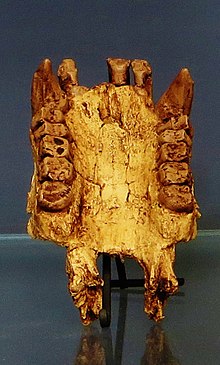Morotopithecus is a genus of fossil ape discovered in Miocene-age deposits of Moroto, Uganda.
| Morotopithecus Temporal range: Miocene,
| |
|---|---|

| |
| Jaw | |
| Scientific classification | |
| Domain: | Eukaryota |
| Kingdom: | Animalia |
| Phylum: | Chordata |
| Class: | Mammalia |
| Order: | Primates |
| Suborder: | Haplorhini |
| Infraorder: | Simiiformes |
| Family: | †Proconsulidae |
| Genus: | †Morotopithecus Gebo et al., 1997 |
| Species: | †M. bishopi
|
| Binomial name | |
| †Morotopithecus bishopi | |
The phylogenetic status of Morotopithecus bishopi is debated to the extent that it challenges established views on the connection between Miocene primates and extant hominids (i.e. great apes).[2] Parsimonious phylogenetic analyses indicate Morotopithecus is more derived than Proconsul,[3] Afropithecus, and Kenyapithecus, but less derived than Oreopithecus, Sivapithecus, and Dryopithecus. Under this arrangement, Morotopithecus would be a sister taxon to extant great apes while Hylobates (gibbons) seem to have branched off before this clade appeared. However, gibbons are believed to have branched off 18 million years ago while Morotopithecus is dated to more than 20.6 million years.[4]
In a comparison of teeth characteristics of Morotopithecus to Afropithecus the results showed little difference, plus evidence gathered from cranial comparisons also indicate that the two genera may be the same, a conclusion of limited confidence due to the lack of evidence to produce a complete anatomy for both (Patel, Grossman 2005).[5] Meanwhile, Pickford (2002) referred the vertebrae to Ugandapithecus, and considered Morotopithecus synonymous with Afropithecus.[6]
It appears to have lived in wooded grassland, and had a diet dominated by leaves.[7]
References
edit- ^ D. L. Gebo, L. MacLatchy, R. Kityo, A. Deino, J. Kingston, D. Pilbeam (1997). "A hominoid genus from the early Miocene of Uganda". Science. 276 (5311): 401–404. doi:10.1126/science.276.5311.401. PMID 9103195. Archived from the original on November 10, 2021.
{{cite journal}}: CS1 maint: multiple names: authors list (link) - ^ Filler, Aaron G. (10 October 2007). "Homeotic Evolution in the Mammalia: Diversification of Therian Axial Seriation and the Morphogenetic Basis of Human Origins". PLOS ONE. 2 (10): e1019. Bibcode:2007PLoSO...2.1019F. doi:10.1371/journal.pone.0001019. PMC 2000357. PMID 17925867.
- ^ Maclatchy, L. (2004). "The oldest ape (abstract)". Evolutionary Anthropology. 13 (3): 90–103. doi:10.1002/evan.10133. Archived from the original on November 14, 2023.
- ^ Young, Nathan M; MacLatchy, Laura (2004). "The phylogenetic position of Morotopithecus". Journal of Human Evolution. 46 (2): 163–184. Bibcode:2004JHumE..46..163Y. doi:10.1016/j.jhevol.2003.11.002. PMID 14871561.
- ^ Biren A. Patel, Ari Grossman (2006). "Dental metric comparisons of Morotopithecus and Afropithecus: Implications for the validity of the genus Morotopithecus". Journal of Human Evolution. 51 (5): 506–512. Bibcode:2006JHumE..51..506P. doi:10.1016/j.jhevol.2006.07.002. ISSN 0047-2484. PMID 16914180.
- ^ M. Pickford (2002). "New reconstruction of the Moroto hominoid snout and a reassessment of its affinities to Afropithecus turkanensis". Human Evolution. 17 (1): 1–19. doi:10.1007/BF02436425.
- ^ "Early Apes Lived on Savannas, Not in Forests". Smithsonian Magazine. Archived from the original on October 25, 2023.
Further reading
edit- Page, Michael Le (2023-04-13). "Early break-up of eastern African forests shaped our ape ancestors". New Scientist. Archived from the original on September 30, 2023. Retrieved 2024-02-13.